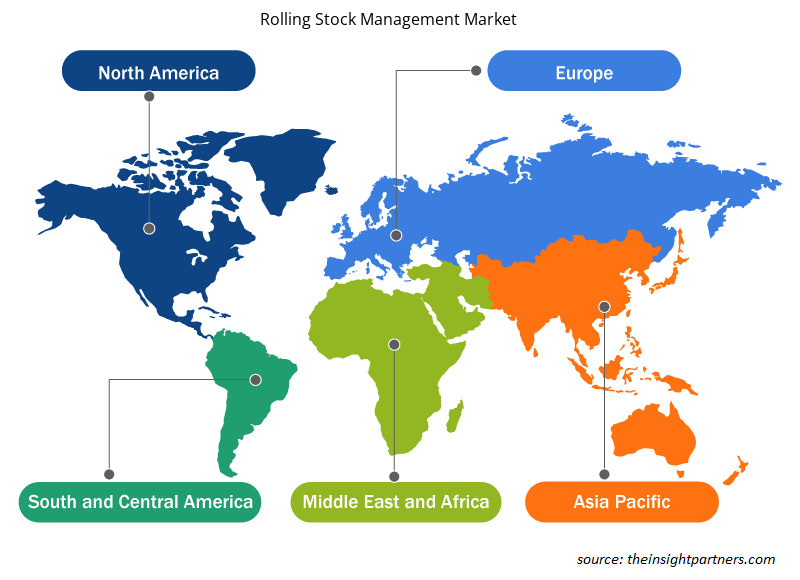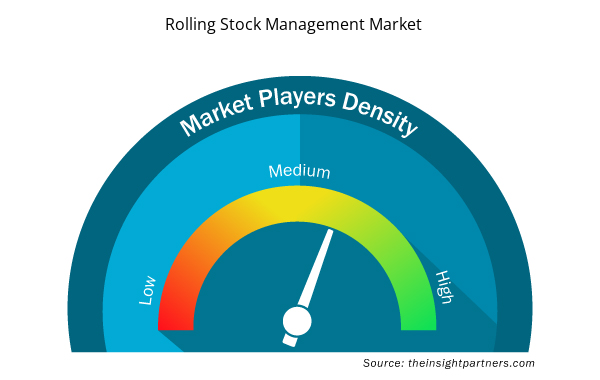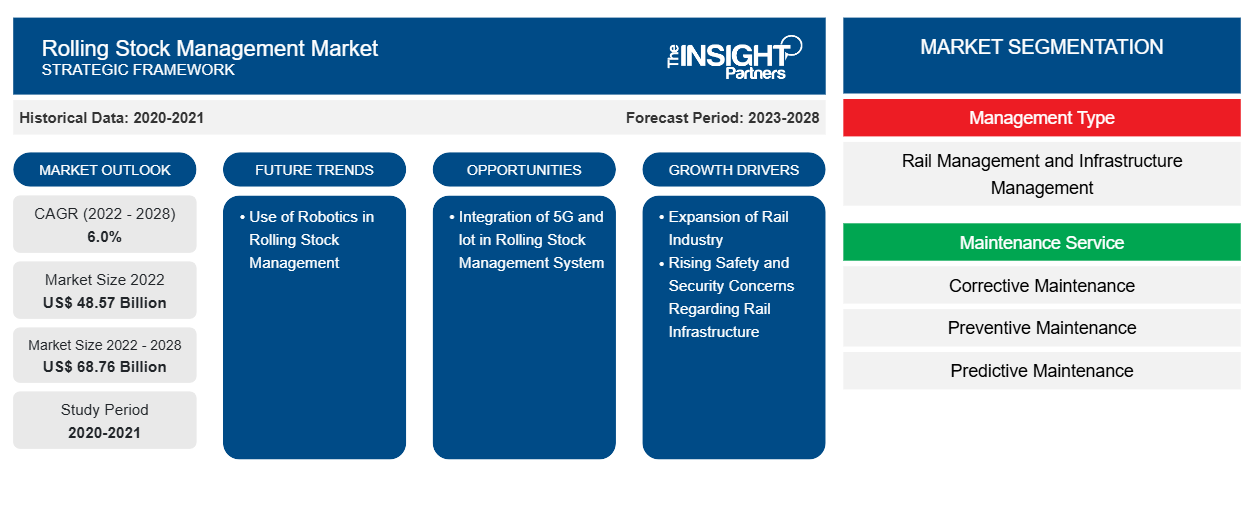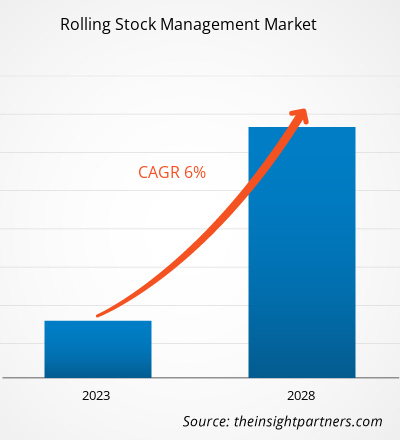[Rapporto di ricerca] Il mercato della gestione del materiale rotabile è stato valutato a 48.571,46 milioni di dollari nel 2022 e si prevede che raggiungerà i 68.761,96 milioni di dollari entro il 2028; si stima che registrerà un CAGR del 6,0% dal 2022 al 2028.
Prospettiva dell'analista:
Il materiale rotabile si riferisce ai veicoli ferroviari che includono sia veicoli motorizzati che non motorizzati. Si riferisce a qualsiasi veicolo ferroviario che può muoversi sui binari. La manutenzione, il monitoraggio delle informazioni e la gestione del materiale rotabile sono le caratteristiche principali del sistema di gestione del materiale rotabile. Mantiene le informazioni relative alla corsa, nonché ai registri di guasti e ispezioni del materiale rotabile . Memorizza inoltre i registri del materiale rotabile dalla sua fabbricazione alle informazioni relative ai suoi principali accessori. La gestione del registro storico del materiale rotabile aiuta i lavoratori, durante la sua ispezione e guasto, a gestire in modo efficiente il loro lavoro. Inoltre, questo sistema aiuta a collegare collettivamente queste informazioni ai sistemi di gestione del traffico, ai sistemi di materiale e contabilità, ai piani di trasporto, ecc. Pertanto, il sistema di gestione del materiale rotabile è necessario per determinare le prestazioni ottimali del materiale rotabile e del settore ferroviario.
Panoramica del mercato: mercato della gestione del materiale rotabile
L'ascesa del settore ferroviario è uno dei principali fattori che contribuiscono al mercato della gestione del materiale rotabile . Il crescente numero di inaugurazioni di nuove stazioni ferroviarie e l'espansione della rete ferroviaria generano la necessità di un efficiente sistema di gestione del materiale rotabile per gestire il materiale rotabile, il suo percorso e la manutenzione.
Di seguito sono menzionate alcune delle principali stazioni e progetti di ampliamento ferroviario:
- Nel marzo 2022, le ferrovie dell'Arabia Saudita (SAR) hanno inaugurato la stazione ferroviaria passeggeri di Al-Qurayyat, nell'ambito del piano della SAR di lanciare i treni passeggeri diretti a nord.
- A marzo 2023, l'Indian Central Railways (CR) Authority ha annunciato il suo piano per costruire sei nuove stazioni ferroviarie suburbane per soddisfare i treni locali di Mumbai. CR Mumbai ha 80 stazioni e con l'aggiunta di queste sei stazioni, il valore raggiungerà 86.
Personalizza questo report in base alle tue esigenze
Riceverai la personalizzazione gratuita di qualsiasi report, comprese parti di questo report, o analisi a livello nazionale, pacchetto dati Excel, oltre a usufruire di grandi offerte e sconti per start-up e università
- Scopri le principali tendenze di mercato in questo rapporto.Questo campione GRATUITO includerà analisi di dati che spaziano dalle tendenze di mercato alle stime e alle previsioni.
Driver di mercato: mercato della gestione del materiale rotabile
Espansione dell'industria ferroviaria
La domanda di servizi di trasporto migliorati sta crescendo rapidamente in tutto il mondo. Secondo l'Agenzia Internazionale per l'Energia (IEA), rispetto al 2019, si prevede che le attività di trasporto passeggeri e merci raddoppieranno entro il 2050. Secondo il Gruppo della Banca Mondiale, le ferrovie sono considerate tra i modi più efficienti per trasportare passeggeri e merci. A causa delle crescenti attività di trasporto, il Gruppo della Banca Mondiale sta investendo nello sviluppo del settore ferroviario per renderlo più efficiente. Molte organizzazioni stanno estendendo il loro supporto ai governi di vari paesi in via di sviluppo nella riforma dell'infrastruttura ferroviaria e nell'incorporazione delle ferrovie nella rete di trasporto di un paese. Inoltre, i governi dei paesi in via di sviluppo stanno investendo per potenziare il loro settore ferroviario. Secondo l'India Brand Equity Foundation, entro il 2030, il paese investirà circa 715,41 miliardi di dollari per l'infrastruttura e lo sviluppo ferroviario. Per gestire l'aumento del traffico passeggeri e merci, i paesi stanno espandendo la loro infrastruttura ferroviaria. Ad esempio, a settembre 2022, il Dipartimento dei trasporti del Connecticut (CTDOT) ha aperto una nuova stazione ferroviaria nella contea di Hartford, negli Stati Uniti. Inoltre, a gennaio 2022, il Ministro degli investimenti dell'Arabia Saudita ha annunciato l'obiettivo del Paese di espandere la rete ferroviaria di 8.000 km. Il sistema di gestione del materiale rotabile aiuta a migliorare le prestazioni ottimali del materiale rotabile. L'aumento dell'espansione e dello sviluppo del settore ferroviario sta creando una domanda di materiale rotabile come locomotive , vagoni merci e treni passeggeri, il che aumenta ulteriormente la domanda di un efficiente sistema di gestione del materiale rotabile.
Analisi segmentale: mercato della gestione del materiale rotabile
In base al tipo di gestione, il mercato della gestione del materiale rotabile è diviso in gestione ferroviaria e infrastruttura. In base al servizio di manutenzione, il mercato della gestione del materiale rotabile è suddiviso in manutenzione correttiva, manutenzione preventiva e manutenzione predittiva. Geograficamente, il mercato della gestione del materiale rotabile è segmentato in Nord America, Europa, Asia Pacifico, Medio Oriente e Africa e Sud America.
Analisi regionale: mercato della gestione del materiale rotabile
Il mercato della gestione del materiale rotabile è suddiviso in cinque regioni principali: Nord America, Europa, Asia Pacifico (APAC), Medio Oriente e Africa (MEA) e Sud America (SAM). La crescita del mercato globale della gestione del materiale rotabile aereo è attribuita all'aumento del traffico passeggeri e all'aumento delle stazioni ferroviarie. La maggior parte delle reti ferroviarie convenzionali si trova in Nord America, Europa e APAC. Secondo i dati della Federal Transit Administration del 2019, queste regioni rappresentano circa il 90% dei movimenti globali di passeggeri su rotaia convenzionale, con l'India in testa al 39%, seguita dalla Cina al 27%, dal Giappone all'11% e dall'Unione Europea al 9%. Il crescente numero di infrastrutture e passeggeri sta aumentando la necessità di acquistare questo materiale rotabile per soddisfare la domanda di maggiori servizi di manutenzione. Pertanto, l'aumento del numero di stazioni ferroviarie sta aumentando la domanda di servizi di gestione del materiale rotabile per efficienza, affidabilità e sicurezza tra ferrovie e stazioni, alimentando il mercato della gestione del materiale rotabile.
Analisi dei principali attori: mercato della gestione del materiale rotabile
Alcuni dei principali attori che operano nel mercato della gestione del materiale rotabile sono Alstom SA, Hitachi Rail Ltd, ABB Ltd, Mitsubishi Electric Corp, Siemens Mobility GmbH, Talgo SA, Thales SA, Toshiba Infrastructure Systems and Solutions Corp, Trimble Inc e LocoTech LLC. Molte aziende stanno investendo nella gestione del materiale rotabile a causa dei potenziali miglioramenti correlati all'accuratezza, all'efficienza operativa e all'evasione tempestiva degli ordini del materiale rotabile.
Approfondimenti regionali sul mercato della gestione del materiale rotabile
Le tendenze regionali e i fattori che influenzano il mercato della gestione del materiale rotabile durante il periodo di previsione sono stati ampiamente spiegati dagli analisti di Insight Partners. Questa sezione discute anche i segmenti e la geografia del mercato della gestione del materiale rotabile in Nord America, Europa, Asia Pacifico, Medio Oriente e Africa e America centrale e meridionale.

- Ottieni i dati specifici regionali per il mercato della gestione del materiale rotabile
Ambito del rapporto di mercato sulla gestione del materiale rotabile
| Attributo del report | Dettagli |
|---|---|
| Dimensioni del mercato nel 2022 | 48,57 miliardi di dollari USA |
| Dimensioni del mercato entro il 2028 | 68,76 miliardi di dollari USA |
| CAGR globale (2022 - 2028) | 6,0% |
| Dati storici | 2020-2021 |
| Periodo di previsione | 2023-2028 |
| Segmenti coperti | Per tipo di gestione
|
| Regioni e Paesi coperti | America del Nord
|
| Leader di mercato e profili aziendali chiave |
|
Densità degli attori del mercato: comprendere il suo impatto sulle dinamiche aziendali
Il mercato del Rolling Stock Management Market sta crescendo rapidamente, spinto dalla crescente domanda degli utenti finali dovuta a fattori quali l'evoluzione delle preferenze dei consumatori, i progressi tecnologici e una maggiore consapevolezza dei vantaggi del prodotto. Con l'aumento della domanda, le aziende stanno ampliando le loro offerte, innovando per soddisfare le esigenze dei consumatori e capitalizzando sulle tendenze emergenti, il che alimenta ulteriormente la crescita del mercato.
La densità degli operatori di mercato si riferisce alla distribuzione di aziende o società che operano in un particolare mercato o settore. Indica quanti concorrenti (operatori di mercato) sono presenti in un dato spazio di mercato in relazione alle sue dimensioni o al valore di mercato totale.
Le principali aziende che operano nel mercato della gestione del materiale rotabile sono:
- Alstom SA
- ABB Ltd
- Hitachi Rail Italia
- Mitsubishi Electric Corp
- Siemens Mobility GmbH
Disclaimer : le aziende elencate sopra non sono classificate secondo un ordine particolare.

- Ottieni una panoramica dei principali attori del mercato della gestione del materiale rotabile
Sviluppi recenti: mercato della gestione del materiale rotabile
Le strategie inorganiche e organiche, come fusioni e acquisizioni, sono ampiamente adottate dalle aziende nel mercato della gestione del materiale rotabile. Di seguito sono elencati alcuni recenti sviluppi chiave del mercato della gestione del materiale rotabile:
- Nel 2023, Alstom ha firmato un contratto con la Port Authority di New York e New Jersey e il Newark Liberty International Airport per fornire servizi di gestione e manutenzione per il suo sistema monorotaia Innovia, AirTrain Newark, per i prossimi sette anni entro gennaio 2030. Il contratto ha un valore di oltre 260 milioni di dollari e include un'opzione per un anno aggiuntivo.
- Nel 2023, ABB ha ricevuto 170 milioni di dollari in ordini da Stadler, una multinazionale svizzero-svedese, per alimentare oltre 300 nuovi treni e locomotive. I treni sono stati utilizzati in varie reti ferroviarie europee per modernizzare e rafforzare il trasporto ferroviario in paesi come Regno Unito, Spagna, Portogallo, Germania e Austria, nonché in alcuni corridoi ferroviari europei.
- Nel 2023, Siemens Mobility ha consegnato 1.200 locomotive elettriche e ha promesso 35 anni di manutenzione full-service. Questo è considerato il più grande ordine di locomotive nella storia di Siemens Mobility e di Siemens India. Con questo, Siemens Mobility ha rafforzato la sua posizione sul mercato.
- Nel 2022, Thales ha dimostrato alle parti interessate una nuova tecnologia ferroviaria che ha reso la rete ferroviaria del Regno Unito più sicura per i lavoratori dei binari, gli equipaggi dei treni e i passeggeri. Thales ha collaborato con Network Rail e la West Somerset Railway (WSR) per eseguire una dimostrazione dal vivo del suo Train Protection and Warning System-Continuous Supervision (TPWS-CS).
- Analisi storica (2 anni), anno base, previsione (7 anni) con CAGR
- Analisi PEST e SWOT
- Valore/volume delle dimensioni del mercato - Globale, regionale, nazionale
- Industria e panorama competitivo
- Set di dati Excel



Report Coverage
Revenue forecast, Company Analysis, Industry landscape, Growth factors, and Trends

Segment Covered
This text is related
to segments covered.

Regional Scope
North America, Europe, Asia Pacific, Middle East & Africa, South & Central America

Country Scope
This text is related
to country scope.
Domande frequenti
APAC is anticipated to grow with the highest CAGR over the forecast period.
The rolling stock management market was estimated to be US$ 48,571.46 million in 2022 and is expected to grow at a CAGR of 6.0 %, during the period 2022 - 2028.
The military drone market is expected to reach US$ 68,761.96 million by 2028
The key players, holding majority shares, in rolling stock management market includes Alstom SA, Siemens Mobility GmbH, Mitsubishi Electric Corp, Hitachi Rail Ltd, and Toshiba Infrastructure Systems and Solutions Corp.
The use of 5G in the rolling stock management provides higher bandwidth for the data transmission between the rolling stock and authorities engaged in its management. It also improves train-to-ground communications and helps the operators make better decisions regarding the action needed to maintain the reliable operation of the rolling stock.
1. Expansion of Rail Industry
2. Rising Safety and Security Concerns Regarding Rail Infrastructure
Trends and growth analysis reports related to Automotive and Transportation : READ MORE..
The List of Companies - Rolling Stock Management Market
- Alstom SA
- ABB Ltd
- Hitachi Rail Ltd
- Mitsubishi Electric Corp
- Siemens Mobility GmbH
- Talgo SA
- Thales SA
- Toshiba Infrastructure Systems and Solutions Corp
- Trimble Inc
- LocoTech LLC
The Insight Partners performs research in 4 major stages: Data Collection & Secondary Research, Primary Research, Data Analysis and Data Triangulation & Final Review.
- Data Collection and Secondary Research:
As a market research and consulting firm operating from a decade, we have published and advised several client across the globe. First step for any study will start with an assessment of currently available data and insights from existing reports. Further, historical and current market information is collected from Investor Presentations, Annual Reports, SEC Filings, etc., and other information related to company’s performance and market positioning are gathered from Paid Databases (Factiva, Hoovers, and Reuters) and various other publications available in public domain.
Several associations trade associates, technical forums, institutes, societies and organization are accessed to gain technical as well as market related insights through their publications such as research papers, blogs and press releases related to the studies are referred to get cues about the market. Further, white papers, journals, magazines, and other news articles published in last 3 years are scrutinized and analyzed to understand the current market trends.
- Primary Research:
The primarily interview analysis comprise of data obtained from industry participants interview and answers to survey questions gathered by in-house primary team.
For primary research, interviews are conducted with industry experts/CEOs/Marketing Managers/VPs/Subject Matter Experts from both demand and supply side to get a 360-degree view of the market. The primary team conducts several interviews based on the complexity of the markets to understand the various market trends and dynamics which makes research more credible and precise.
A typical research interview fulfils the following functions:
- Provides first-hand information on the market size, market trends, growth trends, competitive landscape, and outlook
- Validates and strengthens in-house secondary research findings
- Develops the analysis team’s expertise and market understanding
Primary research involves email interactions and telephone interviews for each market, category, segment, and sub-segment across geographies. The participants who typically take part in such a process include, but are not limited to:
- Industry participants: VPs, business development managers, market intelligence managers and national sales managers
- Outside experts: Valuation experts, research analysts and key opinion leaders specializing in the electronics and semiconductor industry.
Below is the breakup of our primary respondents by company, designation, and region:

Once we receive the confirmation from primary research sources or primary respondents, we finalize the base year market estimation and forecast the data as per the macroeconomic and microeconomic factors assessed during data collection.
- Data Analysis:
Once data is validated through both secondary as well as primary respondents, we finalize the market estimations by hypothesis formulation and factor analysis at regional and country level.
- Macro-Economic Factor Analysis:
We analyse macroeconomic indicators such the gross domestic product (GDP), increase in the demand for goods and services across industries, technological advancement, regional economic growth, governmental policies, the influence of COVID-19, PEST analysis, and other aspects. This analysis aids in setting benchmarks for various nations/regions and approximating market splits. Additionally, the general trend of the aforementioned components aid in determining the market's development possibilities.
- Country Level Data:
Various factors that are especially aligned to the country are taken into account to determine the market size for a certain area and country, including the presence of vendors, such as headquarters and offices, the country's GDP, demand patterns, and industry growth. To comprehend the market dynamics for the nation, a number of growth variables, inhibitors, application areas, and current market trends are researched. The aforementioned elements aid in determining the country's overall market's growth potential.
- Company Profile:
The “Table of Contents” is formulated by listing and analyzing more than 25 - 30 companies operating in the market ecosystem across geographies. However, we profile only 10 companies as a standard practice in our syndicate reports. These 10 companies comprise leading, emerging, and regional players. Nonetheless, our analysis is not restricted to the 10 listed companies, we also analyze other companies present in the market to develop a holistic view and understand the prevailing trends. The “Company Profiles” section in the report covers key facts, business description, products & services, financial information, SWOT analysis, and key developments. The financial information presented is extracted from the annual reports and official documents of the publicly listed companies. Upon collecting the information for the sections of respective companies, we verify them via various primary sources and then compile the data in respective company profiles. The company level information helps us in deriving the base number as well as in forecasting the market size.
- Developing Base Number:
Aggregation of sales statistics (2020-2022) and macro-economic factor, and other secondary and primary research insights are utilized to arrive at base number and related market shares for 2022. The data gaps are identified in this step and relevant market data is analyzed, collected from paid primary interviews or databases. On finalizing the base year market size, forecasts are developed on the basis of macro-economic, industry and market growth factors and company level analysis.
- Data Triangulation and Final Review:
The market findings and base year market size calculations are validated from supply as well as demand side. Demand side validations are based on macro-economic factor analysis and benchmarks for respective regions and countries. In case of supply side validations, revenues of major companies are estimated (in case not available) based on industry benchmark, approximate number of employees, product portfolio, and primary interviews revenues are gathered. Further revenue from target product/service segment is assessed to avoid overshooting of market statistics. In case of heavy deviations between supply and demand side values, all thes steps are repeated to achieve synchronization.
We follow an iterative model, wherein we share our research findings with Subject Matter Experts (SME’s) and Key Opinion Leaders (KOLs) until consensus view of the market is not formulated – this model negates any drastic deviation in the opinions of experts. Only validated and universally acceptable research findings are quoted in our reports.
We have important check points that we use to validate our research findings – which we call – data triangulation, where we validate the information, we generate from secondary sources with primary interviews and then we re-validate with our internal data bases and Subject matter experts. This comprehensive model enables us to deliver high quality, reliable data in shortest possible time.


 Ottieni un campione gratuito per questo repot
Ottieni un campione gratuito per questo repot